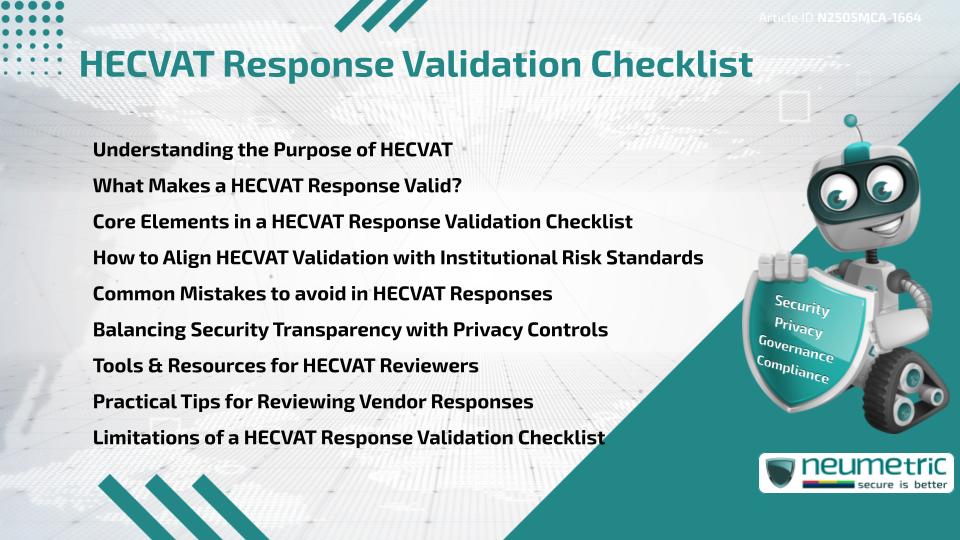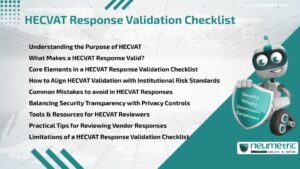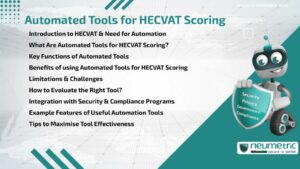Table of Contents
ToggleIntroduction
The Higher Education Community Vendor Assessment Tool [HECVAT] was developed to help academic institutions evaluate Third Party service providers. Its growing adoption in the higher education sector has brought a critical need for a reliable HECVAT response validation checklist. Whether you are part of a procurement team, IT office or security committee, this checklist ensures consistent & effective vendor Risk Assessments.
But what should be validated & how do you know if a vendor’s response truly meets institutional expectations?
This article explores the components, Best Practices & limitations of a HECVAT response validation checklist in a structured & readable format.
Understanding the Purpose of HECVAT
HECVAT was created by Internet2’s HEISC to simplify & standardize how educational institutions assess cloud & Third Party vendors.
The tool:
- Identifies Information Security Risks
- Ensures alignment with institutional Policies
- Helps compare vendors with consistent baselines
A HECVAT response validation checklist supports this process by guiding reviewers through each question’s intent & ensuring answers reflect real practices, not just ideal responses.
What Makes a HECVAT Response Valid?
A valid response is not just complete but also consistent, transparent & verifiable.
Validation should answer:
- Are all mandatory fields filled?
- Is the information clear & unambiguous?
- Does the response align with known industry practices?
- Are security claims backed by Certifications or documentation?
Responses that appear vague or overly generic may indicate that the vendor either lacks maturity or is trying to avoid disclosure.
Core Elements in a HECVAT Response Validation Checklist
The HECVAT response validation checklist should cover several core areas:
- Completeness: Has the vendor answered every applicable question?
- Accuracy: Are technical details consistent across sections?
- Clarity: Are terms & processes well explained?
- Evidence: Are there links to supporting documents such as ISO 27001 or SOC 2 reports?
- Consistency: Are there conflicting statements across responses?
Checklists that include predefined scoring or color-coding (e.g. red/yellow/green) can simplify comparison between vendors.
HECVAT Validation with the Institutional Risk Standards
Every institution has a different tolerance for Risk based on its size, mission & data sensitivity. Validation should reflect:
- Risk tiers: Critical vs low-Risk vendors
- Contractual obligations: Especially for federal funding or FERPA requirements
- Technical dependencies: Integration with internal systems or networks
Using a tiered HECVAT response validation checklist can help prioritise vendor reviews based on the institution’s Core Functions.
Common Mistakes to avoid in HECVAT Responses
Vendors often misunderstand or misrepresent their controls. Reviewers should be on the lookout for:
- Copy-paste errors from unrelated assessments
- Security buzzwords without context
- Incomplete answers masked as “Not Applicable”
- Over-reliance on Third Party hosting without internal responsibility
The HECVAT response validation checklist helps identify these red flags before they result in security issues.
Balancing Security Transparency with Privacy Controls
Institutions often require vendors to disclose significant security details. However, vendors are also protective of proprietary methods.
A good HECVAT response validation checklist encourages enough detail for trust without violating vendor Privacy. Using data classification guidelines can help determine how much disclosure is appropriate.
Tools & Resources for HECVAT Reviewers
Several resources support institutions in reviewing vendor submissions:
- The official HECVAT Workbook Templates
- Risk Management guidance from Educause
- Online community feedback from other institutions
These tools can complement your internal HECVAT response validation checklist & help maintain reviewer consistency.
Practical Tips for Reviewing Vendor Responses
Here are five quick tips to improve your HECVAT validation process:
- Use checklists with binary checks (Yes/No) for quick screening
- Develop a scorecard with weightings for critical sections
- Validate responses using evidence like system diagrams or pen test reports
- Cross-reference against other standards like NIST CSF
- Train multiple reviewers to spot inconsistencies & bias
Standardization improves both accuracy & fairness in the review.
Limitations of a HECVAT Response Validation Checklist
No checklist can fully replace good judgment. Here are the main limitations:
- Subjectivity: Some answers depend on interpretation
- Context loss: Without verbal explanations, answers may appear vague
- Reviewer bias: Checklists do not eliminate personal bias entirely
- One-size-does-not-fit-all: Not every question is relevant for every vendor
To overcome this, combine the checklist with Stakeholder interviews or vendor calls when needed.
Takeaways
- The HECVAT response validation checklist ensures vendor answers are consistent, complete & credible
- Use the checklist alongside Risk tiers & institutional goals
- Avoid generic responses & validate with evidence
- Balance security transparency with confidentiality
- Support reviews with tools, templates & internal discussion.
FAQ
What is a HECVAT response validation checklist?
It is a structured tool used by educational institutions to verify the accuracy & completeness of vendor responses in the HECVAT questionnaire.
How does the checklist help in Third Party Risk Management?
It standardizes the review process, flags incomplete or unclear answers & helps institutions make informed decisions about vendor Risk.
Can a vendor reuse responses from another Client?
While vendors may reuse answers, they must tailor them to match your institution’s context. Generic copy-paste responses often miss key points.
Should smaller vendors be required to meet the same checklist criteria?
All vendors should meet baseline security requirements, but institutions can apply proportional Risk scoring based on vendor size & data access.
What happens when a vendor refuses to complete the HECVAT assessment?
Certain institutions might decline to work with the vendor or ask for a different type of assessment. The checklist helps document this decision.
How do HECVAT Lite & the full HECVAT differ in their application?
HECVAT Lite is designed for third-party providers that present minimal risk to the institution. The selection between the Lite and full version should correspond to the vendor’s assessed risk level & the classification of data they will handle.
What is the recommended frequency for reviewing & updating the HECVAT validation checklist?
It’s best to review it annually or whenever there is a change in institutional Risk posture or regulatory obligations.
Need help?
Neumetric provides organisations the necessary help to achieve their Cybersecurity, Compliance, Governance, Privacy, Certifications & Pentesting goals.
Organisations & Businesses, specifically those which provide SaaS & AI Solutions, usually need a Cybersecurity Partner for meeting & maintaining the ongoing Security & Privacy needs & requirements of their Clients & Customers.
SOC 2, ISO 27001, ISO 42001, NIST, HIPAA, HECVAT, EU GDPR are some of the Frameworks that are served by Fusion – a centralised, automated, AI-enabled SaaS Solution created & managed by Neumetric.
Reach out to us!





